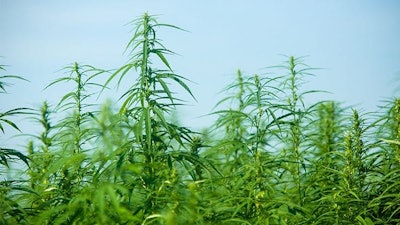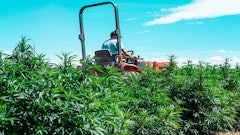
Hemp has thousands of uses, many of which proponents believe have long-lasting environmental benefits. Harnessing hemp to make biofuels is one such path toward a greener future, though growers interested in entering this space might have to wait a little while longer.
“There’s not a market right now," says Dr. Robert Pearce, Ph.D., who’s leading a University of Kentucky (UK) study on hemp cultivars as a potential catalyst for biofuel and other bioproducts. “Right now it’s more of a research question as to how efficient we can be in the process.”
In a process called cellulolysis, harvested hemp plant material is shredded and chemically heated to release cellulose, Pearce says. Enzymes are used to break the cellulose into sugars, which in turn are fermented into ethanol. Finally, the ethanol is purified and distilled into viable biofuel products like biodiesel, which could be utilized to fuel an engine or even a biomass power plant.

Hempseed, fiber, leaves and any other above-ground part of the plant have potential to be sources of biofuel, according to UK and University of Connecticut (UConn) researchers. But to capitalize on this, North American hemp growers would benefit from a national biofuel-creation push that includes new regional infrastructure and an embrace of innovative technologies, say industry observers interviewed by Hemp Grower.
Pearce, extension professor in the College of Agriculture, Food and Environment at UK, says having a biofuel ecosystem in place would be an enormous step forward for farmers seeking entry into the marketplace.
“You need that infrastructure in place, because you’re dealing with bulky biomass material,” Pearce says. “Transportation is going to eat farmers up if they have to bring that material very far. We need regional centers where farms have a short distance to go for processing.”
A Plant with Possibilities
In a lab setting, at least, hemp biofuel has shown promise: A decade ago, researchers at UConn found that industrial hempseeds can be used to create a sustainable diesel fuel.
Comprised primarily of hempseed oil, hemp biodiesel could theoretically power any conventional diesel engine. In the UConn study, 97% of the hemp oil was converted to biodiesel, proving it has “high efficiency of conversion,” according to UConn.
At UK, scientists recently studied dual-purpose cultivars with the best biofuel potential based on hempseed oil and fiber profiles. The cultivars included six that produced fiber only and five that generated both fiber and grain. Dual-purpose cultivars are thought to have higher projected economic returns than the fiber-only cultivars, with Bialobrzeskie from Poland and Colorado’s NWG 331—both dual-purpose—deemed the top-performing varieties for biofuel.
Dr. Jian Shi, Ph.D., an assistant professor in the Department of Biosystems and Agricultural Engineering at UK who is another leader on the study with Pearce, says Bialobrzeskie had estimated returns from grain sales and biofuel production of $1,564 per hectare. Meanwhile, NWG 331 had projected returns of $1,482 per hectare, along with the highest biomass yield and second highest grain yield of all cultivars.
In a previous study, Shi’s team learned that, for a given amount of biomass, hemp has biofuel-producing

potential comparable to other bioenergy crops such as kenaf, switchgrass and sorghum. Where the plant shines is in its higher yield per hectare—agronomy data suggest the per-hectare yield of hemp stems alone is at the same level as entire switchgrass and sorghum crops.
“For growers, hemp can be more profitable [than other bioenergy crops] because you have both the fiber and grain,” says Shi. “The fiber can also be used to make paper, clothing, building materials and more.”
Beyond hempseed oil, the plant has potential to produce ethanol and methanol, both forms of alcohol that can be used as fuel. Cellulolysis ferments and distills hemp biomass to extract ethanol. Methanol is generally produced from woody plant matter through the process of dry distillation.
The majority of biofuel currently comes from corn or sugarcane. Although their high sugar content is a robust source of ethanol, utilizing these plants for fuel production can cut into a farm’s food manufacturing profits, says Pearce. Conversely, the leaves and cellulose fibers from hemp are not valuable food sources.
Only the Beginning
Researchers and industry observers alike say further investigation is needed into hemp’s agronomic practices, postharvest processing and biofuel conversion rates.
When matched with traditional fossil fuels and other sources of biofuel, converting hemp fibers into fuel is a more intensive process, Pearce notes. For instance, where fermentation is the single step needed for sugarcane, hemp material must be pre-treated before this process can take place.
“You need a technical understanding of the processes of those enzymes, and [you need] bioreactors on hand to have that happen at scale,” says Pearce. “Having small-scale processors on site would help with transportation problems, but my vision is more about regional processing centers and growers within a 50-mile radius bringing product to a center.”

In an ideal scenario, farmers would be responsible for storage, as well as the same cutting and baling equipment deployed to cultivate hemp fiber, Pearce says. Plentiful plant populations are needed to create biomass on a large scale, he adds, though with hemp being a photoperiod-sensitive plant, a consistent crop would be a challenge. Development of additional cultivars adapted to specific regions would be necessary for optimization.
“With current varieties, the northern part of the Midwest is where most grain production is taking place,” Pearce says. “We need varieties better adapted to conditions in the south and southeast. The southeast would be an ideal location for biomass production, because you have a longer growing season. Enzymatic processes then have to be optimized to get the most energy production out of hemp, because we’re competing with other sources of biofuel such as corn and soybeans, and other biomass crops like native grasses. That means you have to be as efficient as possible in the extraction process.”
Early application studies at UK and UConn show the potential of hemp as a biofuel, even if little work has taken place outside the lab.
“Not using fossil fuels is in itself a huge net gain,” says Jody McGinness, executive director of the Hemp Industries Association. “Science shows that biofuel burns cleaner and is a less energy-intensive product.”
However, there’s yet to be a strong national push on hemp fiber extraction, much less on the biofuel side itself. While federal farm bill legislation protects hemp research, it hasn’t created a system where people can freely grow the crop as they would tomatoes or basil. With the science currently in its infancy, the same “agricultural backbone” enjoyed by other industries will be key to hemp biofuel’s ultimate success, notes McGinness.
“Producing and sourcing needs to be co-located,” McGinness said. “You’ve got to have a production plant with enough farms around it for growers to add hemp to their rows.”
Douglas J. Guth is a Cleveland Heights, Ohio-based freelance writer and journalist. His work has been published by Fresh Water Cleveland, Crain’s Cleveland Business and Community College Journal.

























